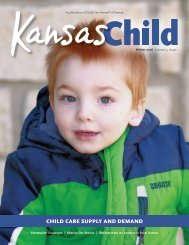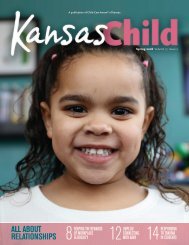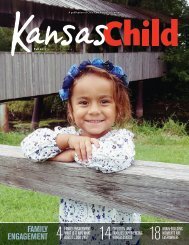2021Winter KansasChild_Final (3)
You also want an ePaper? Increase the reach of your titles
YUMPU automatically turns print PDFs into web optimized ePapers that Google loves.
Picking Up
the Pieces
An Overview of Child Care Aware of America’s Report
on COVID-19’s Impact on the Child Care Systemtracking
BY DIONNE DOBBINS
Long before COVID-19, the U.S. child care system was in
trouble. Last year, Child Care Aware® of America explored that
broken system in our report, The U.S. and the High Price of Child
Care. We found it was fragmented, inequitable, inaccessible, and
underfunded. When COVID-19 was layered onto the already
fragile child care system, it shattered.
Child Care Aware® of America (CCAoA) has been tracking
data on the pandemic’s effect on the child care system. In Fall
2020, we released our report, Picking Up the Pieces: Building a Better
Child Care System Post COVID-19. It would be tone deaf to
speak only about what the child care system looked like in 2019
when so much changed over the first half of 2020. So, we gathered
as much information and updated data as possible about the effects
of COVID-19 on the child care system.
Our report is broken into chapters on Access, Affordability and
Quality. Below are some key findings:
ACCESS
• From 2018 to 2019, 79% of states reported a decrease in
the number of family child care providers and 53% of states
reported a decrease in the number of centers.
• More than 30 states were able to provide us with child
care supply data as of July 2020. When we compare these
numbers to 2019, we found that 35% of centers and 21% of
family child care providers remained closed nationwide as of
July 2020.
AFFORDABILITY
• The national price for child care in 2019 ranged from
$9,200 to $9,600 – about 10% of median income for a
married-couple family and about 34% of income for a
single parent.
• We don’t have the data needed to determine if
COVID-19 has made child care less affordable. However,
providers tell us that increased costs associated with health
and safety supplies, and reduced group sizes have cut into
their already-fragile income.
• In our report, we feature a case study from Child Care
Aware® of Washington (CCAoWA). They found massive
budget shortfalls for providers during COVID-19,
especially for toddler and preschool classrooms, due in
part to reduced group sizes. Although restrictions are
being lifted across the country, the financial damage on
these providers could be long term.
QUALITY
• In 2019, our annual survey responses indicated Quality
Rating Improvement System (QRIS) participation
rates averaged about 63% for centers and 52% for FCCs
nationally.
• The long-term effect of COVID-19 on quality child care
remains to be seen. We partnered with Early Learning
Ventures (ELV), a child care data management program
based in Colorado to analyze their data on quality.
In Colorado, Level 5 is considered the highest quality. Starting
in March 2020, all providers regardless of quality level had
sharp declines in attendance due to the COVID-19 pandemic.
However, providers with lower QRIS levels are recovering a bit
faster than providers at Levels 4 and 5.
We found that providers at Colorado’s highest QRIS level
(the gold line) began the year with an average attendance of
around 37 children. As of July, attendance among this group of
providers had dropped about 40%
When we look at Level 1 providers (the black line), they began
2020 with an average attendance of around 23 children. By
July, their attendance had decreased only by 29%.
This dataset showed that providers with higher QRIS levels
are not recovering as fast as providers with lower QRIS
levels, at least in terms of attendance. This is just a sample of
providers in one state, so we can’t generalize these findings
across the country. However, it would be interesting to see if
similar trends are being seen by a larger sample of providers
nationwide and if so, to explore possible reasons.
• The ELV case study includes a subset of child care providers in
one state. More research is needed to determine if this trend
is seen in other states by a larger number of providers.
18
A Publication of Child Care Aware ® of Kansas
















